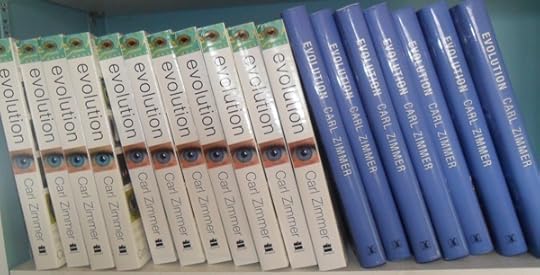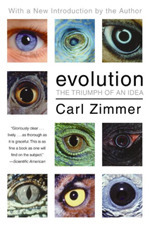Carl Zimmer's Blog, page 62
June 16, 2011
Sex with someone from the future can be hazardous to your health
[image error]There comes a time in every science writer's career when one must write about female sea monkeys having sex with male sea monkeys from the future, and the troubles that follow.
That time is now.
In many species of animals, males and females have a conflict of evolutionary interests. Males compete with each other for the opportunity to fertilize the eggs of females. Males use all sorts of strategies in these competitions. They fight with each other for territory, they scare off intruding males, they put scrapers into females to dump out the sperm from previous males, and they inject "anti-aphrodiasiacs" to make females unreceptive to other males.
A number of experiments suggest that females have to pay a steep price for these male shenanigans. Anti-aphrodisiacs are toxic to the females, shortening their lifetime. Why would males harm the females that carry their offspring? In many species, males can mate with many females. The long-term health of any one female doesn't matter–in an evolutionary sense–to the male.
As natural selection favors increasingly deadly male mating strategies, this onslaught opens up the opportunity, in turn, for the evolution of counterstrategies in females. In some species, ...

June 14, 2011
Science Ink: Spreading the Word
 Here's the final version of the cover of Science Ink: Tattoos of the Science Obsessed. It now includes Mary Roach, who kindly provided a lovely foreword for the book.
Here's the final version of the cover of Science Ink: Tattoos of the Science Obsessed. It now includes Mary Roach, who kindly provided a lovely foreword for the book.
Science Ink will be hitting book stores on November 1. Here are a couple blurbs…
"How apt: the most enduring ideas in science translated into that most enduring personal art—the tattoo. Science Ink marries mind and body, and Zimmer reveals the beauty that motivates so many scientists."–Sam Kean, author of The Disappearing Spoon
"After spending long hours at the computer, in the lab or field, science has a way of getting under your skin. S cience Ink reveals the great ideas and deep passion for science revealed in some of the most creative body art on the planet today. This is a book to revel on the best ideas and discoveries in science and of the passion scientists have for their life's work."–Neil Shubin, University of Chicago, author of Your Inner Fish
"Here is to be found the evidence that scores of intelligent and intellectually perceptive young people recognise that equations, symbols and structures are the key constituents of the ...

Virus as Koosh ball: My favorite image of the day

The other day I got the July issue of American Scientist and was tickled to no end to see this portrait of mimiviruses on the cover. As I write in A Planet of Viruses, mimiviruses were literally hiding in plain sight for years. Scientists considered them to be bacteria because they were too big to be viruses (see the minuscule HIV and rhinovirus, the cause of colds, for scale). It turns out they are indeed viruses, and perhaps the most interesting viruses on Earth. They may even represent an ancient branch of the tree of life, reaching back several billion years.
Check out James Van Etten's excellent review of the science of giant viruses in the magazine.

Darwin+Hip Hop+Off Broadway=Baba Brinkman
During the World Science Festival, I met Baba Brinkman, who performs hip hop about, among other things, evolution. He let me know that his "Rap Guide to Evolution" will be opening this Friday at the SoHo Playhouse in New York. Here are details about the venue and getting tickets.
Here are a couple videos from Baba…
Here's a one called, "Performance, Feedback, Revision":
Here's Baba at TEDxKids:

June 13, 2011
This shelf is for you: American paperback edition of Evolution, and UK hardback edition
 Thanks to all the Loominaries who have taken extra copies of my books off my hands–or, to be more specific, off my shelves. On Friday, I offered autographed copies of the US hardback edition of Evolution: The Triumph of An Idea, and you cleaned me out in a few hours. Here is a picture of what I've got to offer today: two other editions of Evolution. If you'd like one of these books autographed and shipped to you, go to my Amazon store and order a copy.
Thanks to all the Loominaries who have taken extra copies of my books off my hands–or, to be more specific, off my shelves. On Friday, I offered autographed copies of the US hardback edition of Evolution: The Triumph of An Idea, and you cleaned me out in a few hours. Here is a picture of what I've got to offer today: two other editions of Evolution. If you'd like one of these books autographed and shipped to you, go to my Amazon store and order a copy.
To the left are 11 copies of the original paperback edition of Evolution. They have the same lavish color illustrations inside as in the original hardback edition. (They're not in print anymore; the paperback edition you'll find in stores now contains straight text–an unfortunate matter of publishing economics.) This week, I'll be offering autographed copies for $15. You can order a copy here.
 To the right are 7 copies of the UK hardback edition. The only difference between them and the original US edition is that they have ...
To the right are 7 copies of the UK hardback edition. The only difference between them and the original US edition is that they have ...

June 10, 2011
We purge, you save: Autographed US first hardback edition of Evolution: The Triumph of an Idea
 In the continuing quest to avoid packing boxes before our house gets ripped open for renovations this summer, allow me to offer you–for one week only!–another sale. I've got 33 autographed copies of the first US hardback edition of Evolution: The Triumph of An Idea, which are available for $20. (The cover price is $40, and this particular edition has been out of print for some time now.)
In the continuing quest to avoid packing boxes before our house gets ripped open for renovations this summer, allow me to offer you–for one week only!–another sale. I've got 33 autographed copies of the first US hardback edition of Evolution: The Triumph of An Idea, which are available for $20. (The cover price is $40, and this particular edition has been out of print for some time now.)
This book was a companion to a series that aired in 2001 on PBS. But it's not a nonfiction novelization of the show. In fact, the show hadn't even been shot when I started working on the book a year earlier. Instead, I wrote a stand-alone introduction to the history of evolutionary biology and to its many avenues, from sex to mass extinctions to the rise of our species. The publishers packed the large-format book with photographs and color artwork. "Zimmer writes in a gloriously clear and lively style," wrote a reviewer for Scientific American. "His coverage is as thorough as it is graceful. This is as fine a book as one will find on the subject."
If this sale is like ...

June 9, 2011
My Long Now lecture: Viral Time (slides and audio)
I just got back from San Francisco, where I had the privilege to speak at the remarkable Long Now Foundation. Stewart Brand, the head of the foundation, invites people to talk to the group about topics that stretch our conception of time over long scales. So I spoke about viruses and time–how they exist at scales ranging from minutes to eons. The Long Now folks have just posted the audio, which I've embedded below. I've also embedded the slides for my talk, too.
If I can win the battle against an army of deadlines this week, I'll try to write out the entire talk as I did with "The Human Lake." But I've learned not to make hard promises.
Audio:
Slides:
Viral Time: Carl Zimmer's talk at the Long Now Foundation
View more presentations from cwzimmer

June 8, 2011
The Mind After Midnight: Here's the video from the World Science Festival
Last week I was thrilled to moderate a World Science Festival panel about the mysteries of sleep and dreams. The video is now up here. I'm also embedding it below (if WordPress plays nice with the code…). Be sure to watch till the end, when you can learn about snore-gasms.
I've actually written about Niels Rattenborg, one of the panelists before, in a piece for the New York Times. I also wrote about the researchers he's now collaborating with, who put transmitters on birds that go on ultra-long migrations.
Watch live streaming video from worldsciencefestival at livestream.com

June 6, 2011
The two faces of E. coli: my article in Newsweek and interview with the BBC
 On Friday, as the E. coli outbreak gained horrific speed in Germany, Newsweek asked me to write about how this epidemic came to be. Scientists still have a lot to figure out about it, but some things are clear–in particular, that the bacteria have great scope for evolution into new deadly strains, thanks in part to the shuttling of viruses between them. (In my book Microcosm, I explain how this is true not just for E. coli, but for much of life.) My piece appears in the new issue of Newsweek, which you can read online here. (One late-breaking piece of news that didn't make it in, by the way, is the finding yesterday that the new outbreak appears to have come from bean sprouts.)
On Friday, as the E. coli outbreak gained horrific speed in Germany, Newsweek asked me to write about how this epidemic came to be. Scientists still have a lot to figure out about it, but some things are clear–in particular, that the bacteria have great scope for evolution into new deadly strains, thanks in part to the shuttling of viruses between them. (In my book Microcosm, I explain how this is true not just for E. coli, but for much of life.) My piece appears in the new issue of Newsweek, which you can read online here. (One late-breaking piece of news that didn't make it in, by the way, is the finding yesterday that the new outbreak appears to have come from bean sprouts.)
While I was working on my Newsweek piece, a reporter for the BBC called me up for an article on the good side of E. coli. I explained how much of how we understand about life itself came out of research on this typically harmless bug, and that the biotechnology industry was build upon its biology. That piece came out over the weekend. Check ...

June 4, 2011
Time to vote for the 3 Quarks Daily Science Prize
The folks at 3 Quarks Daily are winnowing down the entrants for the best science blog post of the year. They want you to help select the finalists by voting for your favorite post from the 87 nominees. (The Loom makes an appearance at #76 with "The Human Lake.") You can vote till June 8, 11:59 PM EST.





















